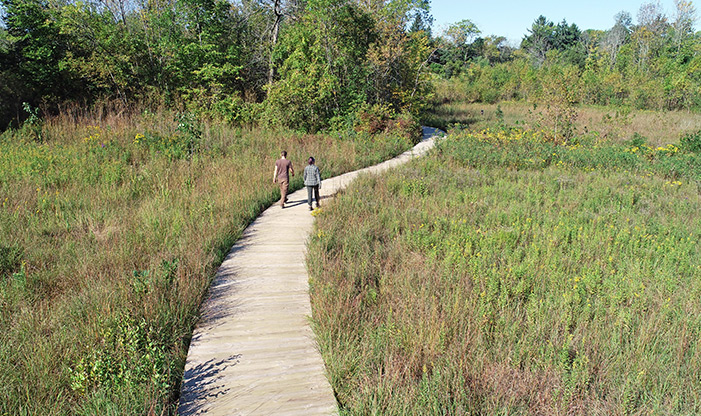We intentionally measure every conservation action we take at Schlitz Audubon by the impact it will have in the decades to come. Careful stewardship of our unique habitats both ensures their long-term health and helps educate the next generations of those who will care for them. The establishment of our wet prairie, a rare habitat, is a prime example of this philosophy at work.
Visitors traversing our new 1,570-foot Gateway Trail have the unique opportunity to witness a wet prairie, one of Wisconsin’s rarest habitats. Once abundant, this habitat type has been reduced to less than one percent of its original footprint across the state.
Easy Access to a Rare Habitat
The Gateway Trail is entered off our parking area, making this special habitat extremely easy to access. Observation of wet prairie in our region was previously much harder to accomplish: the next closest example is nearly 50 miles from the Center. With the new trail, our prairie can be accessed by anybody—whether on foot, stroller, or wheelchair—in mere minutes.
The Gateway Trail was designed for easy access while still maintaining the integrity of the ecosystem. After a wetland delineation in 2017, it was determined that 23 acres, or about 16% of Center habitat, is wetland. Visitors can recognize that they’re traveling through wetland by the presence of boardwalks. These help prevent disturbance to sensitive plant and animal populations while providing an elevated view of our distinctive habitats.
Plant Life in the Wet Prairie
The boardwalk view of the wet prairie is spectacular, showcasing a mass of tall sedges and grasses punctuated by plants associated with wetter habitats, like Joe Pye Weed, Boneset, and Turtlehead. Ongoing restoration will continue to increase its splendor in the years to come. This year alone, staff and volunteers installed 4,000 plants throughout the prairie, like Glade Mallow, Prairie Violet, and Swamp Milkweed, that will attract and sustain the native pollinators that rely on them.
Thanks to our many conservation project funders, transformations like this one are occurring across the Center. Together we will restore and protect Wisconsin’s natural heritage for generations to come.


